Deep Cycle Batteries are distinct from regular car batteries, despite their similar appearance. While Deep Cycle Batteries are engineered to consistently deliver power over an extended duration until depletion, Car Batteries are specifically designed to provide brief, intense bursts of energy for starting vehicles. Consequently, Car Batteries are commonly referred to as Starter Batteries. Once the vehicle is ignited, the car’s alternator takes over and generates the necessary power.
An important difference between Deep Cycle Battery and regular Car Battery is that deep cycle batteries can be discharge up to 80% of its capacity (although it is not recommended to discharge a battery below 50%), whereas the car battery must be almost fully charged at all times i.e., they can be discharged only to a small % of their capacity (usually, 2% to 5%) before they are recharged.
So, where are Deep Cycle Batteries used? They are used in applications where it is necessary for the battery to be able to deliver sustained / stable power over an extended duration. The first application that comes to mind is the UPS or Uninterruptable Power Supply.
Some of the other applications of Deep Cycle Batteries are:
- Golf Carts
- RVs
- Boats (and other Marine applications)
- Wheel Chairs
- Electric Vehicles (EVs)
- Emergency Lighting
- Medical Devices
- Industrial Fork Lifts and Floor Sweepers
- Off-grid Energy Storage (Solar, Wind)
- Uninterruptable Power Supply (UPS)
There is a right deep cycle battery for every need. If you are in the market for a Deep Cycle Battery, then you have to be aware of some important specs of the battery in order to analyze the battery before making a purchase.
Below are the three main considerations to check out…
- Type: There are two types of deep cycle batteries – Lithium-Ion and Lead Acid (Flooded, AGM and Gel). Of these two, the lead-acid type dominates the market while the Lithium-Ion batteries are slowly becoming popular.
- Capacity: This capacity rating is given in Ah (Amp Hour). Simply speaking, the ‘Ah’ rating of a battery specifies the amount of current a battery can supply for a certain duration.
- Discharge Cycle: It represents how many times the battery can be discharged and recharged. It is better to go for a model with higher discharge / charge cycles for long life.
There are several other factors as well to consider – that are clearly mentioned in the “Buying Guide”.
Using the same information, we tested and analysed several products. After that, we have shortlisted the Best Deep Cycle Batteries based on the results.
8 Best Deep Cycle Batteries List
| Deep Cycle Batteries | Battery Type | Capacity | Warranty | Warranty |
|---|---|---|---|---|
| Ampere Deep Cycle Battery | Lithium-ion | 300 Ah | 10 year long | Check On Amazon Check On dhgate |
| Universal Deep Cycle Battery | AGM | 100 Ah | 1 year | Check On Amazon Check On Walmart |
| ExpertPower Deep Cycle Battery | Lithium-ion | 100 Ah | --- | Check On Amazon |
| ML Deep Cycle Battery | Flooded Lead-acid | 100 Ah | 1 year | Check On Amazon Check On eBay |
| Optima Deep Cycle Battery | AGM | 55 Ah | 3 year long | Check On Amazon Check On Batteriesplus |
| Interstate Deep Cycle Battery | AGM | 35 Ah | 5 year long | Check On Amazon Check On Walmart |
| Chins Deep Cycle Battery | Lithium-ion | 300Ah | 10 year long | Check On Amazon |
| Battle Deep Cycle Battery | Lithium-ion | 100Ah | 10 year long | Check On Amazon Check On Walmart |
8 Best Deep Cycle Batteries Reviews
1. Li Time LiFePO4 Deep Cycle Battery
The Li Time Group has been in the field of manufacturing LiFePO4 batteries for more than 14 years. Li Time’s 12V 300Ah LiFePO4 Deep Cycle Battery serves as a very versatile solution for motor homes, campers and solar power applications.
It has a 100% depth of discharge. So, you can use the battery until it drains completely, without any loss in output power. After the battery is drained completely, you have to recharge the battery with a maximum continuous charging current of 200A (although this is not recommended).
You also get a discharge cycle count of over 4000 cycles. After this, you will experience a drop in the capacity but the power will still be sufficient for your needs. With a maximum discharge current of 200A (and up to 5 second discharge of 400A peak current), you can easily use it for loads up to 2560W.
One thing that Li Time has really focused on is the safety aspects of the battery. These batteries are made from automotive-grade LiFePO4 cells. Each cell in the battery has a UL Testing Certificate. If you are looking for the best deep cycle battery for solar power system, then the Li Time LiFePo4 battery is a very good choice.
Besides, it also comes with IP65 level waterproof features. Also, it only weighs 69 lbs., one-third of the weight of relative lead-acid batteries. This makes the battery perfect for outdoor usage.
Li Time LiFePO4 deep cycle battery comes with an 5-year service warranty. If there is an issue, the brand will troubleshoot the battery free of cost.
Pros:
- High capacity of 300Ah
- High discharge cycle of 4000 counts (up to 6000 cycles with reduced capacity)
- IP65 Waterproof feature (Ideal for outdoor use)
- 5-year warranty
Cons:
- Questionable BMS for Low temperature cut-off protection.
Buy Now From Amazon Buy Now From dhgate
2. Universal VRLA Deep Cycle Battery
Next on our list is Universal Power Group’s deep cycle battery. Universal Power Group is a popular manufacturer of a wide range of batteries that are used for diverse applications.
This deep cycle battery comes with a capacity of 100Ah. Although this capacity is not very high, this would be sufficient to power up your mini trailers, golf carts, and campers.
The battery is lightweight with only 63.93 lbs and measures 0.48 x 0.26 x 0.33 inches. This compact and lightweight nature of the battery allows you to carry it easily and install it anywhere you want.
This is a VRLA battery which means it has a spill-proof design that allows you to mount it any position without the worry of any leakage or spillage. Besides, the battery is also resistant to shocks and vibrations. These features make it ideal to be used for golf carts, mini-boats, mini-trailers, or other moving vehicles where there would be a lot of disturbance and vibrations.
As the Universal Power Group’s deep cycle battery is an SLA/AGM type, there is practically no maintenance involved and you can use this battery until it completely drains out.
On top of all these features, the battery is backed by a 1-year warranty from the date of purchase.
Pros
- Suitable for small power demands
- Spill-proof and leakage proof
- Resistant against shocks and vibrations
- Easy to mount
- Zero maintenance
Cons
- Low capacity
- Only a 1-year warranty
Buy Now From Amazon Buy Now From Walmart
3. ExpertPower Deep Cycle Battery
ExpertPower is a reliable brand when it comes to batteries, generators, chargers and solar kits.
Their 12V deep cycle batteries comes with capacity of 33Ah which is sufficient for small applications. However, it may not be an ideal choice for your golf carts, trailers, boats and RVs.
When it comes to the safety aspects of the battery, you can have a sigh of relief. The battery does not release any harmful fumes nor leak as it is an AGM battery. And moreover, it comes with different safety and quality certifications.
The battery is lightweight and only weighs 10.8 Kgs., which is only half the weight of its lead-acid counterpart. However, the capacity will be twice than that.
These batteries come along with valve regulated and spill-proof construction which makes them hassle-free. It is made up of non-conductive ABS plastic material which ensures resistance from shock, heat, chemical and vibration.
Pros
- Rugged batteries construction
- Tough exterior
- High-impact resistance
- Spill-proof design
- Absorbed glass mat technology
- Easy installation
Cons
- Capacity is small
4. Mighty Max AGM Deep Cycle Battery
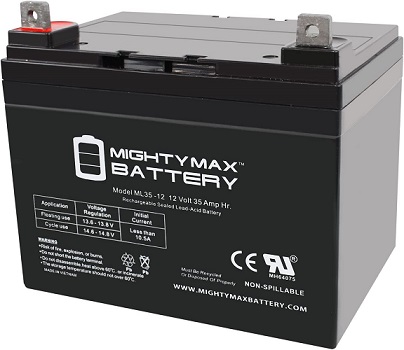
The ML35-12 has a deep cycle layout, permitting it to be discharged and recharged time and again with out harm. The most discharge depth is 50%, and the battery can be recharged with a moderate current of 3.5A, taking about 10 hours to fully recharge.
This battery is good for off-grid solar electricity structures, RVs, golf carts, and extra, with a most energy output of 420W. The ML35-12 has a 1-year warranty, in addition to the 30-day return policy.
In summary, the ML35-12 – 12V 35AH U1 Deep Cycle AGM Solar Battery is a excellent and reliable choice for all small and medium power applications that use deep cycle batteries.
Best Features:
- Battery capacity of 35Ah with a long service life of up to 3-5 years.
- Deep cycle design for repeated discharge and recharge without damage.
- Ideal for off-grid solar power systems, RVs, and golf carts with a maximum output of 420W.
- Backed by a 30-day return policy and 1-year warranty.
Pros:
- Maintenance Free
- Compact
- Decent power
Cons:
- Longer recharge time of approximately 10 hours.
5. Optima Deep Cycle Battery
Optima is one of the most prominent battery brands in the U.S. The brand provides three line of batteries: RedTop, BlueTop and YellowTop. Each one is designed for different purposes.
The Optima OPT8016-103 BlueTop (with light gray case) is a dual purpose battery i.e., you can use it as a starter battery or a deep cycle battery . This is one of the best deep cycle marine battery in the market specifically designed to be used in boats, RVs, golf carts and marine applications.
However, it only has a capacity of 55Ah, which is on the lower side in our list. So, you cannot use it in large trailers or any other purposes where the power demands are high.
With the OPT8016-103 deep cycle battery, you get a reserve capacity of 120 minutes. While it may not seem significant, it will come in handy in emergency situations. One more important thing is that you can recharge this battery up to three times faster than other batteries.
The battery is spill-proof. So, you do not have to be concerned about leakage and you can install the battery at any position. On top of this, it has 15 times more resistance against vibrations. Now, you know why this is a great battery to be used for boats.
Optima provides a 24-month guarantee to all its batteries including this one. You can contact the brand and replace the battery if any issue pops up.
Pros:
- Reserve capacity of 120 minutes
- 15x more vibration resistance
- Can be installed at any position
- Spill-proof and maintenance-free
- 2-year warranty
- Very Affordable
Cons:
- Low capacity
Buy Now From Amazon Buy Now From Batteriesplus
6. Interstate Deep Cycle Battery
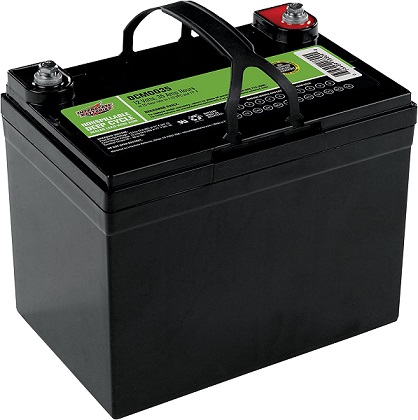
The Interstate Battery 12V 35Ah AGM deep cycle battery with a maximum capacity of 420W is ideal for a variety of applications including off-grid solar power systems, RV and marine applications Also suitable for wheelchair, scooter and other portable devices take people. If you are looking for the best deep cycle battery for trolling motors, then this is a decent option.
The main features of this battery are its deeper maximum discharge depth of 80%, longer usage time between recharges, and fast recharge time of about 8 hours The battery also offers a low self-discharge rate of 91% in 3 months. It is spill-proof and maintenance free due to its sealed design (as it is a VRLA battery). It also works at wide temperatures -40ºF (-40ºC) to 140ºF (60ºC).
The Interstate Batteries 12V 35Ah AGM Deep Cycle Battery is backed by a 12-month replacement warranty, giving you peace of mind that your investment is protected.
In summary, the AGM Deep Cycle Battery is a reliable and efficient battery designed to meet your off-grid power and mobility needs. With its longevity, deep charge and fast recharge time, this battery is destined to provide reliable power for many years to come
Best features:
- 35Ah capacity for reliable power.
- Suitable for off-grid solar power systems, RVs, marine use, and mobility devices.
- Maximum discharge depth of 80% for longer use.
- Recharge time of approximately 8 hours.
- Spill-proof and sealed design for safety and convenience.
- Wide temperature range operation for reliable performance.
- Backed by a 12-month warranty.
Pros:
- Reliable and long-lasting power source.
- Suitable for quite a few programs.
- Deeper discharge depth for longer use among expenses.
- Convenient and secure spill-proof design.
- Wide temperature variety operation.
Cons:
- Lower capacity compared to a few other deep cycle batteries.
- Longer recharge time as compared to some different deep cycle batteries.
7. Chins Deep Cycle Battery
Chins is a relatively small Chinese brand but makes reliable and powerful deep cycle batteries that are safe to use. This Chins 12V LiFePO4 Deep Cycle Battery has a high capacity of 300 Ah. The life of this deep cycle battery is 8-10 times longer than an equivalent lead-acid battery.
One of the best things about this battery is that it has a depth of discharge of 100%. What this means is that you can keep using the battery until it drains completely without any problem. Once it discharges completely, you can recharge it with a standard charge current of 50A (which will take 7 hours to fully recharge). The maximum continuous charge current is 100A (not recommended).
Coming to the discharge, this battery has an impressive 2000 – 5000 discharge / charge cycles at a maximum discharge of 80%. The maximum continuous discharge current is 200A while the peak discharge current is 400A for less than 5 seconds.
The Chins 12V 300Ah LiFePO4 Deep Cycle Battery supports up to 2560W of power output. Hence, it is ideal for RVs (or Caravans), storage for off-grid Solar Power Systems, Marine, CCTV Security Systems, EVs (Cars, Golf Carts) and many more. This is one of the best deep cycle battery for camping and solar applications
The brand offers a 90-day return policy. If any issue arises, you can return the product for a full refund. On top of this, you also get a 3-year replacement warranty and a 10-year service warranty.
Pros:
- High capacity of 300Ah
- Discharge depth of 100%
- Lower cost per Ah.
- High discharge cycle of up to 5000 counts
- Lightweight
- Eco Friendly and does not contain hazardous substances
- 3-year replacement and 10-year service warranty
Cons:
- BMS in some units doesn’t work for low / high voltage protection.
8. Battle Deep Cycle Battery
Based in Reno, Nevada, Battle Born is known for making sustainable green energy batteries. All their batteries are made using Lithium Iron Phosphate (LiFePO4), which are known for their reliability and stability.
The Battle Born 12V 100 Amp Hour LiFePO4 Battery offers 2 to 3 times the power compared to a similar size Lead-Acid Battery. At just 31 lbs., this Battle Born battery weighs only 1/3rd of an equivalent lead-acid battery and also lasts 10 times longer.
Besides, the batteries use 100% safe and renewable energy in the manufacturing. In a way, you will be contributing to sustainable-energy growth by using these green energy batteries.
A problem with Lithium-Ion batteries in general is different charge levels of individual cells. Thanks to the built-in Battery management System (BMS), these batteries have automatic cell balancing and are protected from common battery failures (ground faults, temperature faults and other faults) with low / high voltage protection, low / high temperature protection, short circuit and cold charge protection.
The BMS is also capable of 100 A continuous current, 200 A of surge current for 30s or ½ second of surge current for over 200 A loads.
Coming to discharge / charge cycles, the Battle Born 12V 100 Amp Hour LiFePO4 Batteries have 3000 to 5000 cycles and can be discharged up to 90% of the capacity (where the voltage drops down to just below 12V). Even after the 3000 – 5000 cycles (assuming 80% to 90% discharge), these batteries retain about 70% to 80% of the capacity.
The advantage of Battle Born LiFePO4 batteries is that they can be charged faster (up to 5 times faster) than standard lead acid batteries.
Even though these batteries are readily suitable for all 12V applications, they can used in 24V, 36V or 48V systems by properly connecting them in series. They can be used in RVs, boats, Solar energy storage, etc. If you want the best deep cycle battery for caravan or RV, then this one is for you.
Battle Born has backed this deep cycle battery with a long 10-year warranty period. You can contact the brand if any issue arises and it will replace the product.
Pros:
- More discharge cycles with up to 5,000 counts.
- Claimed Depth of Discharge 100% (recommended up to 90%).
- Lightweight with only 31 lbs.
- Made from 100% safe, non-toxic and renewable energy.
- 10-year replacement warranty
Cons:
- Battery capacity is low (only 100 Ah, but higher capacities are available).
- BMS can be tricky if the battery is discharged down to 10V.
Buy Now From Amazon Buy Now From Walmart
Buying Guide For The Best Deep Cycle Batteries
With so many Deep Cycle Batteries available in the market, it often becomes overwhelming to make a choice. To help you out, we have provided a detailed analysis of several factors that are essential while considering / analyzing a deep cycle battery. Read the below information thoroughly and make an informed decision.
Types Of Deep-Cycle Batteries
At the basic level, we can classify the deep-cycle batteries into two types. They are:
- Lead Acid Batteries
- Lithium-Ion Batteries
Lead Acid Batteries are the dominating entities either in Automotive Starter Batteries or Deep Cycle Batteries. The lead-acid battery technology is proven to be reliable, consistent and cost effective.
The lead-acid batteries can be further divided in to two types:
- Flooded Lead-Acid Batteries
- Sealed Lead-Acid Batteries (or Valve Regulated Lead-Acid Batteries)
Further, the Sealed Lead-Acid Batteries are divided into:
- Absorbent Glass Mat (AGM) Batteries
- Gel Batteries
For easy understanding, let us divide the Deep Cycle Batteries into four types (three are of Lead-Acid type and one Lithium-Ion type).
- Flooded Lead-Acid
- Absorbed Glass Mat (AGM)
- Gel
- Lithium-Ion
Let us get into the construction, performance, durability and other detail of each category.
1. Flooded Lead Acid
The flooded lead-acid battery is one of the most popular and dominating battery types, whether in Automotive (as starter batteries) or storage (as deep cycle batteries). The term ‘flooded’ means the lead plate are submerged in electrolyte fluid (usually, Sulfuric Acid).
During charging, some water is decomposed from the electrolyte. Hence, you must perform regular inspection / maintenance for level of electrolyte and if it is below the desired level, you can top-up with distilled water.
The charging of lead-acid batteries usually takes place in stages, and hence it may lead to overcharging or undercharging, sometimes. When it comes to the cost, they are the least expensive.
The other downside to these batteries is that you must place them only in the upright position because there are chances that the battery’s electrolyte may spill. Moreover, it needs proper ventilation as the battery releases explosive gasses when it is getting charged.
Below are the advantages and disadvantages of a Flooded Lead Acid battery:
Flooded Lead Acid Pros:
- Inexpensive
- The best option when it comes to reliability and working capabilities
- Can withstand overcharging
- Delivers good performance at both low and high temperatures
- The most sold battery worldwide and hence, they are easily available
- Has the lowest self-discharge rate amongst all other rechargeable batteries
- Capable of high discharge rates
- Highly durable
Flooded Lead Acid Battery Cons:
- Require little maintenance (adding distilled water)
- If left discharged for too long, there is a problem of sulfation
- Not environmental-friendly (contains toxic Lead)
- Heavier when compared to other alternatives
- Charges slowly i.e., a fully saturated charge may take up to 14 to 16 hours
- It has a limited life cycle
- Repeated discharge cycle reduces the battery life
- You cannot store it in a discharged state
- Releases gasses (Hydrogen) if overcharged
- It has transportation restrictions
2. Absorbed Glass Mat (AGM) Batteries
Considered as Sealed Lead-Acid batteries, an AGM (Absorbed Glass Mat) battery contains a special fiberglass mat that contains the electrolyte solution between the battery plates.
In AGM Batteries, the electrolyte is in a dry state (in contrast to flooded battery, which has wet electrolyte). While the battery works, the electrolyte moves from the glass mat to the battery plates as required. This mat contains sufficient electrolytes that are adequate for the cell to deliver its full capacity.
Unlike flooded lead-acid batteries, you don’t need to add distilled water to it. Hence, it doesn’t require any maintenance. The batteries have better vibration and shock resistance in comparison with wet or gel batteries.
They have a faster recharge rate than a lead-acid battery. However, they are not as fast or efficient as lithium-ion batteries.
Below are the advantages and disadvantages of AGM (Absorbed Glass Mat)
AGM Battery Pros:
- They have very low internal resistance
- They are capable of delivering high currents when the load demands
- They are maintenance-free
- Lighter than a flooded lead-acid battery
- It charges five times faster than the lead-acid or gel battery
- It offers a depth-of-discharge of 80%
- They have a longer lifespan
- You can store them for an extended period without needing a recharge
- It does not spill
- It can withstand low temperatures
- Has low self-discharge
AGM Battery Cons:
- It is considerably more expensive than lead-acid
- Gradual decline in capacity
- Overcharging the battery can shorten its life and may even ruin it
- You should always store it in a charged condition
- They have low specific energy
Learn more about: How do i Know if my battery is AGM?
3. Gel Batteries
A Gel battery is yet another type of valve-regulated lead-acid battery. In this battery, a special type of gel made from Silica is use to hold the electrolyte. As a result, the overall electrolyte becomes a semi-solid gel like quantity, making it spill-proof and maintenance free.
Gel batteries do not emit any gasses like flooded lead-acid does and hence do not require any ventilation.
Below are the advantages and disadvantages of Gel Batteries.
Gel Battery Pros:
- It is spill-proof
- It does not require maintenance
- It can withstand extreme weather conditions and has great tolerance for heat
- Offers high and stable performance until the end
- Has a longer shelf life
- It has low self-discharge
- Vibration resistant
- Robust and versatile
- Has a longer lifespan
- Has better cycle performance
Gel Battery Cons:
- Has more upfront cost than flooded lead-acid or AGM battery
- It is sensitive to overcharging
- It requires special chargers and regulators
4. Lithium-Ion
These are the newest addition in the battery types. While there are several types of Lithium-Ion Batteries for different applications, the Lithium Iron Phosphate (LiFePO4) type are frequently used in deep cycle type lithium-ion batteries.
These batteries have a cathode made up of Lithium Iron Phosphate and anode made up of graphite carbon. A special solution of lithium salts acts as electrolyte.
The upside to these batteries is that you can discharge them completely without doing any damage. Also, you can recharge them quickly as their recharge rate is the fastest than other battery types. Moreover, they have a longer lifespan and can sustain any weather conditions.
Lithium batteries are light in weight, almost half that of a lead-acid battery. And the best part is that you can install them in any position with zero chances of spilling. The only drawback with these batteries is their price. They are expensive than other types of batteries and are available in limited quantities.
Below are the advantages and disadvantages of a Lithium-ion battery:
Lithium-Ion Battery Pros:
- Their usable capacity is 80% to 100%
- They have a high charge rate
- It does not have memory effect
- Do not require maintenance
- They are lightweight and compact batteries
- 2,000 to 5,000 charge cycles
Lithium-Ion Battery Cons:
- They are very expensive when compared to other battery types
- You cannot charge them at low temperatures (According to a whitepaper released by Battle Born Batteries, they still perform better even at low temperatures)
- A Battery Management System is required (BMS is internally equipped in Deep Cycle type)
What Should You Consider When Choosing A Deep Cycle Battery?
Since you are aware of the different types of batteries, let us now look at some essential factors for choosing the best deep cycle batteries. We will discuss the pre-requisites that you should consider. Make sure you take these into account before making a purchase.
1. Hours of Use / Amp Hours
The key parameter that should come first in your checklist is the battery capacity. It is essential to know how long the battery will last before you need to recharge it again. The measure for battery capacity is ampere-hours or Ah.
Theoretically speaking, the Amp Hour of a battery determines how many amps of current a battery can deliver over a duration of 60 minutes. For example, if you have a 10 Ah battery and connected it to a load that draws 10 Amps of continuous current, then the battery will last for one hour.
Of course, this is just a theoretical explanation and practically speaking, there are other factors like temperature, hour rate, operating conditions, type of load and end voltage that determine the capacity of the battery.
A higher amp-hour rating generally indicates a longer runtime before requiring recharging. This consideration is especially important for applications such as off-grid solar systems, where a reliable and consistent power supply is a priority.
You can calculate the capacity using this simple formula:
Capacity (Ah) = Device Wattage (W) x Time to Run (Hours) / Battery Voltage (V)
2. Size and Weight
The next prominent factor to consider when choosing a battery is the size and weight. The smaller the size of the battery, the easier it is to carry. Size and weight of the battery becomes important for applications with limited space or weight restrictions, such as in marine or RV settings. Balancing the available space and weight capacity with the desired battery capacity is essential. Additionally, portable applications, like camping or boating, may benefit from lightweight and compact deep cycle batteries for ease of handling and transportation. Moreover, if they are lightweight, they do not add weight to your vehicle and you can carry them easily.
3. Voltage Rating
Almost all deep cycle batteries have a Voltage or Volt rating of 12V. The idle voltage and charging voltage might slightly vary depending on the battery technology but they essentially are 12V batteries. If the application needs 12V supply, then you can use these battery directly. You can connect them in parallel to increase the overall capacity but keeping the voltage at 12V.
Alternatively, you can connect batteries in series to increase the voltage (24V, 36V, and 48V) if necessary. However, you cannot mix and match different kinds of batteries in such situations. All the batteries must be of the same type and same voltage.
4. Charge Time
This is the amount of time that the battery will take to recharge after use. If the charge time is lower, it means you can use the battery quickly. The charging time of a deep cycle battery is crucial for applications requiring quick recharging, such as in off-grid systems or electric vehicles. Fast-charging capabilities may be desirable for users who rely on their deep cycle batteries regularly and cannot afford extended downtime during recharging cycles.
5. Depth of Discharge
The depth of discharge (DoD) is another essential factor for consideration. It is basically the total amount of energy discharged from the battery, also expressed as the percentage of the total power capacity of the battery. For example, if a 100 Ah battery undergoes a discharge of 50 Ah, the depth of discharge would be 50%.
Lead-based batteries (Flooded, AGM, and Gel) can typically handle moderate to deep discharges, often ranging from 50% to 80%. Lithium-ion batteries, including lithium iron phosphate (LiFePO4) chemistry, are known for their high depth of discharge capabilities. They can often handle discharges up to 80-90% without significantly impacting their cycle life.
The more often you discharge and charge the battery, greater are the chances of reducing its overall service life. It is suggestible not to discharge your battery completely and only use the maximum recommended DOD as specified by the manufacturer.
6. Discharge Cycle
The discharge cycle or cycle life determines how many times you can discharge / charge your battery before its capacity significantly diminishes. For applications that demand frequent and deep discharges, such as in solar power systems or electric vehicles, a battery with a longer cycle life is preferable. High-quality deep cycle batteries often come with extended cycle life, providing better longevity and overall value for users in need of reliable, long-lasting power storage.
7. Durability
The durability of the product is something that we all pay keen attention to. We all look for devices that long last and that do not need a replacement soon. No matter what type of batter you want to choose, make sure it is highly durable.
Repeated charges and discharges should not affect the life cycle of the battery. Moreover, your battery should be capable of delivering greater performance for high-demand applications like marine, aircraft, and solar energy systems.
Many batteries are susceptible to different factors like temperature, shock, vibrations, etc. Ensure your battery can withstand all the above without compromising its performance and lifespan.
8. Functionality
There are batteries with greater and sophisticated functionality called dual-purpose batteries or hybrid batteries. You can use such models as starter batteries (for starting an engine) as well as for deep cycle usage in UPS, Solar, EVs. Make sure to check for the CCA rating that ensures adequate starting power.
9. Shelf Life
The shelf life of the battery is another deciding factor for choosing the right deep cycle battery. Battery shelf life or battery aging is primarily dependent on three influential factors namely, the chemicals in the cell, its idle time, and the storage temperature.
We all know that many batteries come with high self-discharge rates. In other words, if the self-discharge rate of your battery is high, the sooner it loses its power when being idle.
It becomes a significant concern for all deep cycle batteries as they cannot hold a charge between the usage. It is a growing concern, especially in extreme weather conditions, where high temperatures intensify the self-discharge rate, making it inevitable to all batteries.
The ideal shelf life offered by best deep cycle batteries is around ten years before they start losing the maximum capacity. The not-so-famous or worst batteries guarantee a shelf life of about a year or two.
10. Compatibility
Compatibility is something that you don’t want to compromise with. The battery you choose should be compatible with your vehicle or application, hence do not forget to check for it.
Also, ensure that the Amp hour of the battery are not too high / low, but suitable for your application. Remember that a battery with high Ah takes more time to charge but last longer as well.
11. Brand
Looking for a brand is always preferable if you want to purchase the right deep cycle battery. Many nameless batteries are available in the market, claiming to offer everything you need. Do not fall prey to these false claims, as they do not hold any quality. Always look for famous brands that earned recognition for the quality, ensuring high performance.
12. Charging the Battery
The next parameter in the list to consider is the way you charge the battery. You can either use a generator, solar power, or shore power to charge. You may even use a combination of the three.
If, in case, you do not have any, using a smart charger or charge controller would do the needful. Make sure you are using the correct charging profile suitable for your battery type when using the above method. This will enable an uninterrupted charge supply to your battery.
The controller acts as a guard for your battery by helping you adjust the voltage and current automatically.
13. Power at Low and High Temperatures
Temperature sensitivity is an often-overlooked factor that can significantly impact the performance of deep cycle batteries. Different battery chemistries react differently to temperature variations. The battery you choose should withstand extreme weather conditions. It should be capable of providing power at both low and high temperatures.
Whether you live in cold regions or areas with humidity and high temperature, lookout for a battery that is compatible with use. If you are living in a hot area, then your battery should sustain a temperature of at least 35 degrees.
14. Ability to Withstand Vibrations
The best deep cycle battery should have resistance to vibrations and shocks. A batter with a solid and sturdy construction can easily withstand shocks and vibrations. If in any case, your battery is not shock and vibration-resistant, you will have to spend huge on the expenses incurred for repairs and damages.
15. Warranty
The last and also the most crucial parameter to consider when buying a deep cycle battery is the warranty. While standard batteries do not guarantee long life, these cells last a long time and also offer a high discharge cycle.
Always check for the warranty of your deep cycle battery before you decide on buying one. Most batteries come with a warranty of one year. However, some offer a warranty of 10 years or even more, making it the most reliable.
16. Maintenance Tips
Here are some tips for maintaining your deep cycle batteries. Follow these diligently to keep them running long-term and extend their life:
- Clean the top of the batteries and make sure it is free from dust and dirt. Also, clean the terminals and cables to avoid corrosion build-up.
- Charge the batteries as required. Ensure you charge it fully when not in use.
- If your battery is charging slowly or not charging even after hours of plugging it in, we recommend you check for any bulges or cracks on it. If you find any, it means they are likely defective or damaged.
- During winters, ensure that your battery receives a trickle charge to stay fully charged. Immediately replace the batteries that cannot handle deep discharge. Replacing one chemical battery for another will deter battery life.
- Never mix an old battery with a new one, as it will reduce the device’s performance and may even damage it.
- Store batteries in a secured box that is acid-proof to prevent the effects of vibration and shock. Exposure to vibrations decreases the lifespan of the batteries.
- Monitor the fluid levels (electrolyte) in wet cell batteries and refill them if required.
- Lubricate your corrosion-resistant batteries to boost their shelf life.
How To Get The Best Performance From Deep Cycle Batteries?
If you want to achieve optimum performance from your deep cycle batteries, you need to follow proper care and maintenance. Here are some useful tips to maximize the durability of your battery:
1. Monitor the Charge Levels of Your Battery
Always monitor the charge levels of your deep cycle battery. Start charging them when you see any indication of a 50% charge. But make sure you do not let it go below 20%.
You can use simple tools like digital multimeters to measure battery charge levels.
2. Prevent Sulfation
Prevent the sulfation build-up on the batteries by keeping them charged from time-to-time. Charge your battery even when not in use.
3. Let the Battery Rest
Allow the battery to rest for some time after continuous usage and recharge. Let it cool down before you start using it again. Using the battery immediately after recharging can lead to formation grid corrosion, which may further destroy the battery.
Deep Cycle Batteries – FAQs
Ans. Based on the performance, voltage, current, and capacity, Battle Born Batteries, Universal Power Group, and Optima are the best deep cycle batteries.
Ans. The 100Ah deep cycle battery will last for 1000 hours, depending on the usage. You calculate the Ah rating for most batteries over 20 hours. Here is a simple formula to determine the work hours.
Watts = Volts x Amps.
Ans. With proper care and maintenance, most deep cycle batteries will last up to six years. While lithium batteries may last for about 3 to 20 years, Lead-acid batteries and AGM batteries will last six years each. Gel batteries, on the other hand, can last up to 10 to 20 years.
Ans. The charging time required for batteries varies from type to type.
• Lithium batteries usually take around two to three hours for charging.
• Lead-acid batteries require 8 to 16 hours for charging.
• Gel batteries need about 5 to 10 hours to charge.
• And finally, AGM batteries require a charging time of five hours.
Ans. No, you should not connect different batteries together. You can only connect batteries that are of the same type, and model, and have the same capacity and age. Moreover, they should have an identical size wiring connected to the charging source at the same location.
However, you can connect the starter battery of your camper van engine to the house battery bank using a battery combiner or charging relay. This way, you can charge the house bank through the alternator.
Ans. The number of batteries you need for your trailer is entirely dependent on its size. If it is a small trailer, it requires two batteries, at least, to power your systems. Whereas a big trailer might need up to six or seven batteries. You could also daisy chain the required batteries to form a series or a larger battery. This facilitates in delivering more effective and reliable power
Ans. It is not a good idea to use a deep cycle battery in your car, as it will draw more sustained voltage than required when recharging. This will eventually damage the car alternator. Hence, it is always advisable to use only use car batteries in your car.
Ans. Lithium batteries undoubtedly have the highest energy density when compared to other batteries. Amongst them, the lithium iron phosphate battery is the safest and the long-lived type. Although it has a comparatively lower energy density than lithium cobalt oxide batteries, it is less prone to thermal runaway. Not only that, but it also has a very flat discharge curve and the longest life than any of the lithium chemistries. However, you should have proper maintenance by following good charging practices and moderate temperature conditions
Ans. A. Yes, you can overcharge a deep cycle battery. However, overcharging reduces the lifespan of the battery and also its overall capacity. If you want to prolong the life cycle of the battery, you better avoid doing that.
Get the right charger if you want to avoid overcharging your battery. Usually, you can charge most AGM batteries to a level of 2.4 volts per cell. You can lower it based on the charger you use. If it is a float charger, lower the level to 2.25 volts per cell. In case, if it is hot outside, further lower charging voltage, as high temperature allows fast charging of the batteries.
Conclusion
Unlike the standard batteries used in most vehicles, a deep cycle battery usually offers better performance for storage and sustained power delivery. The deep cycle batteries also last for a longer time with much better discharge / charge cycles. Due to this, the deep cycle batteries are used in boats, RVs, golf carts, Solar Power Systems, Boats, UPS and many more similar applications.
If you are looking for one, then you can pick one from the best deep cycle batteries presented in this article. These batteries have been mentioned with their major features and options. You can also find a detailed buying guide related to deep cycle batteries with all the important factors.
Even though they are little bit expensive, we suggest you to invest in Lithium-Ion type batteries due to their excellent discharge cycle numbers, quick recharge and maximum depth of discharge. However, there are applications/situations where a lead-based battery is much more feasible.
Using to all these details and factors, here are our favorite deep cycle battery recommendations:
- The Chins LiFePO4 Deep Cycle Battery is one of the best deep cycle batteries that we presented in this article. If you need a deep cycle battery for solar, off-grid, or golf carts, then this a very choice. You get a large 300Ah capacity, discharge current of 200A, and importantly 10-year warranty.
- If you want the best deep cycle battery for marine applications, then the Optima Deep Cycle Battery is a good choice. It has a small capacity of 55 Ah and you can use it with boats as well as RVs. As it is an AGM battery, you don’t have to worry about maintenance or spillage.
- In case you are on a budget, then you should consider the Interstate Deep Cycle Battery. It has a small capacity of 35Ah. It is one of the best deep cycle battery for trolling motor or electric scooters.
Make sure to share your thoughts in the comments section. You can also post any questions down there if you have any!

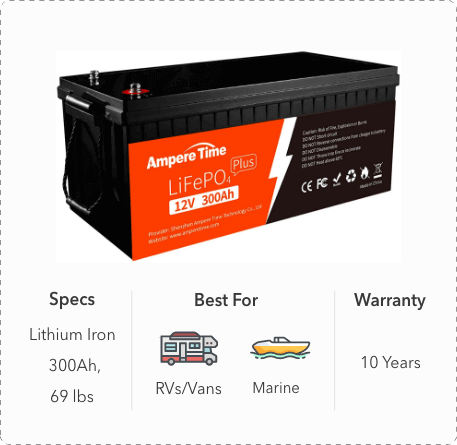
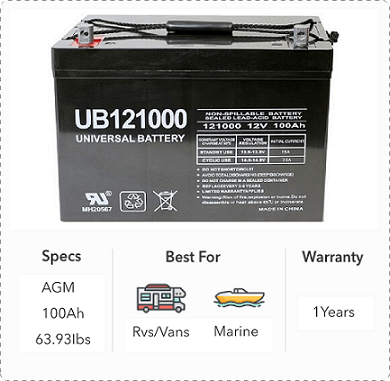
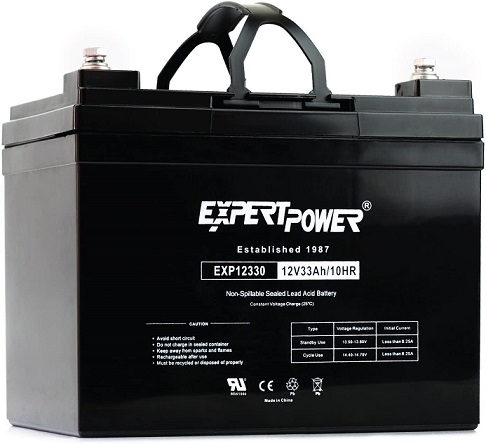
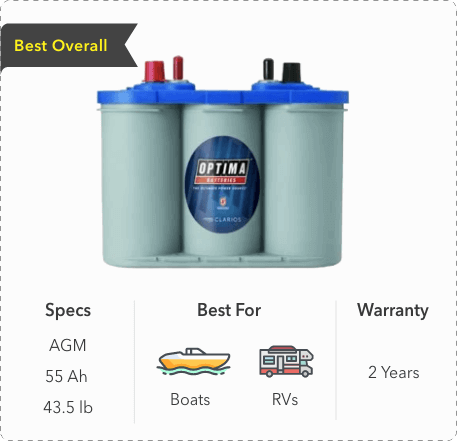
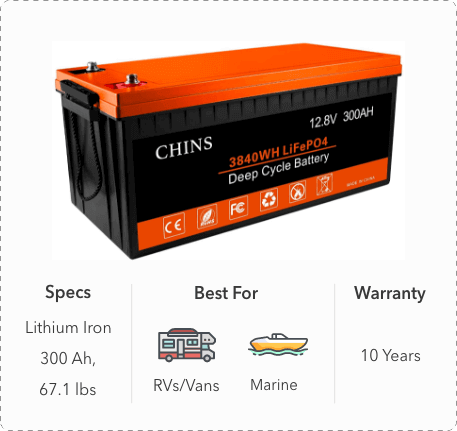
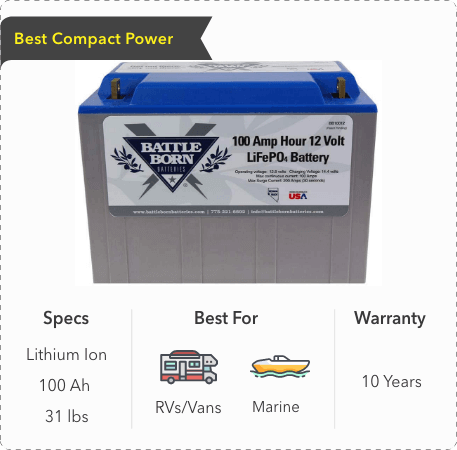

3 Responses
Advise price for the following
300ah battery bank 2v ,deep cycle battery.
I am in Town SOUTH AFRICA. Can we get them here???
Are carbon lead battery’s any better than flooded lead acid.